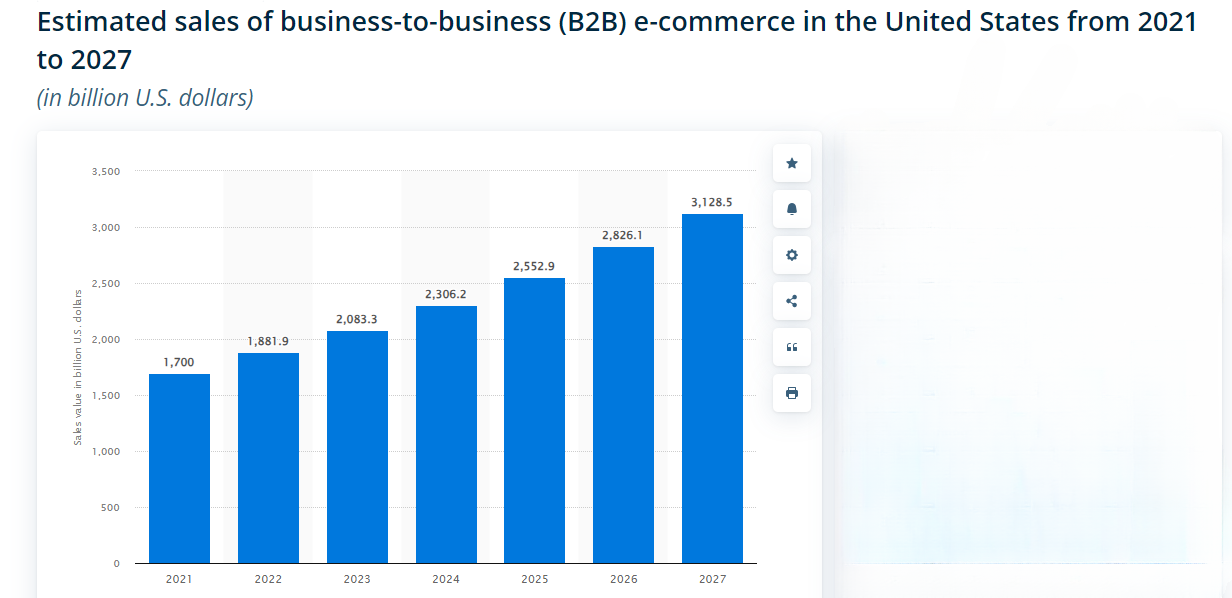The B2B landscape is undergoing a significant transformation from traditional offline practices to a futuristic online environment. According to Statista Report, B2B ecommerce in the U.S. experiencing substantial growth, more than doubling from $3.1 billion in 2009 to $6.7 billion in 2019.
As a result, ecommerce technology has emerged as a top priority for B2B businesses. Approximately 35% of B2Bs have identified investing in ecommerce platform technology as their foremost concern for the next 12 months. Additionally, 54% of distributors are prioritizing enhancing the user experience and incorporating more B2C features.
In this opportune moment, creating a well-thought-out ecommerce strategy is crucial. The first step towards meeting your customers' needs is selecting the right ecommerce platform tailored to your B2B company's requirements.
What Is B2B eCommerce Platform?
B2B ecommerce, defined as the online sale of goods and services between businesses, has revolutionized the digital retail landscape by facilitating the digital processing of orders. This transformation has significantly improved purchasing efficiency and effectiveness for various B2B entities, including B2B2C, wholesalers, manufacturers, and distributors.
Type of B2B Business
When we talk about B2B commerce, one prevalent category involves manufacturers supplying raw materials or components to other businesses in the production chain.
B2B2C
B2B2C, which stands for business-to-business-to-consumer, involves selling directly to consumers without intermediaries. Manufacturers or wholesalers create goods, which are then sold to B2B entities responsible for direct consumer sales.
In an e-commerce scenario, a B2B2C business typically operates a digital storefront displaying its product catalog. Consumers may be unaware that the business doesn't directly produce the showcased products.
Wholesale
Within a wholesale module, businesses procure goods in large quantities from distributors or manufacturers for subsequent retail sales to consumers. For wholesale suppliers seeking efficient product promotion with minimal marketing efforts, buyer oriented B2B marketplaces provide a valuable avenue.
These marketplaces thrive in scenarios with abundant buyers and fewer sellers. In this context, buyers establish their online marketplaces, inviting suppliers and manufacturers to showcase products and receive bids from various sellers.
Manufacturers
Manufacturers produce goods in large quantities, which are then supplied to other entities such as suppliers, wholesalers, or manufacturers. For instance, a manufacturer specializing in shoelaces may sell their product to a luxury shoe manufacturer who incorporates them into their branded shoes.
Various B2B entities and consumers seek enhanced flexibility in purchasing, prompting businesses to require manufacturers to conduct online transactions. This shift involves accessing personalized features like pricing, production schedules, or sizing.
Distributors
Distributors handle tasks such as packaging, shipping, and marketing, alleviating manufacturers from in-house responsibilities they may prefer to outsource. Manufacturers can opt to collaborate with distributors for product sales.
The establishment of a manufacturer-distributor partnership can be facilitated online. Utilizing online platforms to negotiate deals enables manufacturers and distributors to establish faster, more efficient supply chains, ensuring they meet or exceed customer expectations.
Relatable Read: What are the most important eCommerce analytics that I should be paying attention to?
What Makes a Great B2B eCommerce Platform?
Many B2B e-commerce websites effectively implement various features, making them successful examples. When assessing a platform, it's essential to take into account these key features that define B2B e-commerce.
1. Headless Commerce
When talking about headless commerce, it stands out as one of the most rapidly growing trends in e-commerce. The approach highlights various reasons for adopting a headless architecture, emphasizing significant enhancements in site performance and the unprecedented flexibility to make real-time changes.
At first glance, the decision to go headless seems like an obvious choice, doesn't it?
Headless commerce provides retailers with complete creative autonomy, enabling developers to craft tailored e-commerce experiences using their preferred technologies.
However, the implementation of a headless architecture is not as straightforward as it is often portrayed, and there are numerous factors. Thus, to every business owner, it is suggested to know your business needs and requirements before moving from composable to headless.
2. PIM & DAM Integration
Choosing the appropriate PIM solution is paramount and necessitates a comprehensive grasp of the unique requirements of the business.
For example, a distributor of healthcare products would find value in a PIM equipped with robust compliance tracking features to navigate the regulations within the healthcare industry.
On the other hand, a consumer electronics vendor might implement a PIM that excels in advanced digital asset management for showcasing products effectively.
The ideal PIM system should harmonize with the company's operational processes and future expansion strategies, ensuring scalability and flexibility. Seamless integration with the existing tech stack is crucial, delivering a cohesive and unified approach to product information management.
PIM systems play a pivotal role in maintaining data accuracy and consistency, preserving brand integrity, and promoting a strategic approach to disseminating product information.
3. Multichannel OMS
B2B buyers desire not just online purchasing access but also a seamless experience comparable to consumer expectations. Despite some common needs, B2B and B2C differ in factors such as order volume, conversion time, and delivery options.
However, managing diverse customer requirements with various tools can be challenging. The good news is that there's a solution. With a robust order management system, you can streamline processes, track inventory, shipments, and enhance customer experiences, transforming your business into a forward-looking B2B company.
Integrating Multichannel OMS helps you to manage:
⦁ Track Bulk Orders
⦁ Pick-up/Return Orders
⦁ Multichannel Shipping
⦁ Paperless Warehouse
⦁ Single Inventory View
⦁ Purchase Management
⦁ Supplier Management








.png?h=250&fm=webp)
.png?h=250&fm=webp)
.png?h=250&fm=webp)



.png?h=250&fm=webp)
.png?h=250&fm=webp)
.png?h=250&fm=webp)


.png?h=250&fm=webp)



.png?h=250&fm=webp)
















.png?h=250&fm=webp)

.png?h=250&fm=webp)
.png?h=250&fm=webp)



































































































































.png?h=250&fm=webp)


.jpg?h=250&fm=webp)





 copy.png?h=250&fm=webp)























_ Why do you need one.png?h=250&fm=webp)


























































.jpg?h=250&fm=webp)

.png?h=250&fm=webp)



.png?h=250&fm=webp)

.jpg?h=250&fm=webp)




.png?h=250&fm=webp)









.jpg?h=250&fm=webp)
